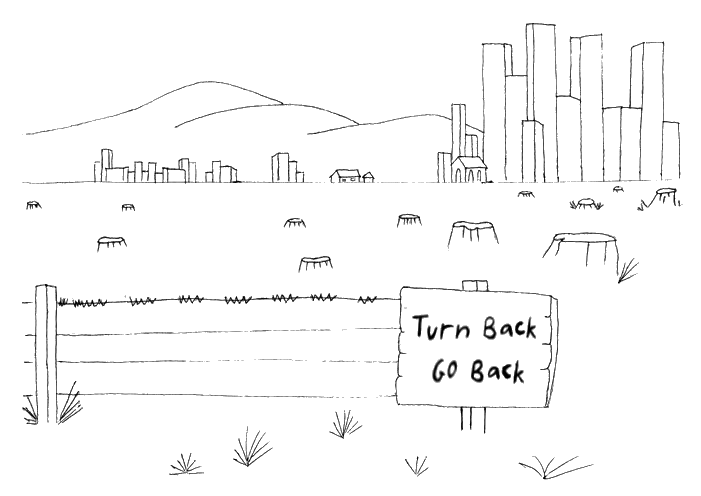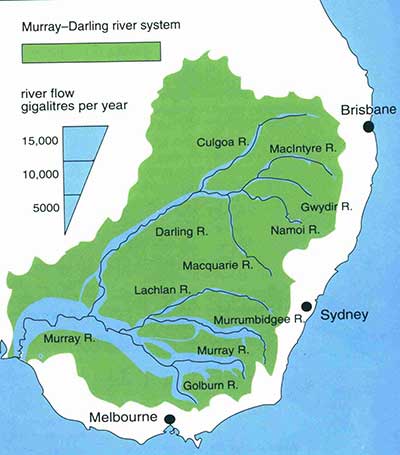

Environment
Landcare and the Murray Darling Basin > Saving the Murray > Life & Death of the BillabongUnderstanding Environmental Economics > How to be Green
Saving the Murray
(17 February 2000)
[Christom]
The continual degradation of the Murray river in recent years has caused it to become one of our most significant National landcare issues; the other of course is our salinity problems which are also interwoven with the river. The Murray-Darling river system extends over four states and is Australia's largest river system. (refer to the map) [1]
 The reason for it being such a well known issue is because of the very nature of our nation and its vulnerability in regards to water.
Mitch O'Toole sums up how critical our water supplies are to our dry and barren land with this quote:
The reason for it being such a well known issue is because of the very nature of our nation and its vulnerability in regards to water.
Mitch O'Toole sums up how critical our water supplies are to our dry and barren land with this quote:
Australia is the driest inhabited continent.The average annual rainfall over the continent is only 465 milliliters, and 87 per cent of this water dries off. Groundwater is the only water source for almost 60 per cent of the country, and the main source for a further 20 per cent. Most Australians live in cities, which causes a basic problem. Australians are concentrated in large groups, and those groups need water. Our regular droughts merely underline this fundamental reality. Australian rivers are small by world standards, our mountains are low, there is only one major reservoir of snow and that is seasonal. The overall flatness of the continent makes places for dams hard to find and the hot dry climate makes water storage less efficient once the dams are built. Much of the stored water evaporates. [2]
The future of South Australia in particular, is significantly influenced by the state of the Murray River. Not only are we dependant on it for our drinking water but also for business and industry. Every area of our social and economic system is tied to water and the decline of the Murray will inevitably bring about a decline in our state and nation as a whole Riverland communities in particular will be impacted upon, if the problems associated with the Murray get worse. Waikerie deputy principal Mr Haines says,
Young people in the area are going to rely on the river and, and if its health fails, then they are the ones who are going to be affected - the economy of the area will be affected and recreation in the area obviously will be affected. [3]
According to the newspaper article 'Our river, our future',
Within 20 years, South Australia's major source of water will not pass World Health Organisation drinking standards on two days out of every five... The Murray was once mighty, but now only 21 per cent of its natural flow reaches its mouth. This is even with the current cap on extractions by irrigators from the Murray and the additional water provided by diversions from the Snowy River. ...our river, faced with increasing levels of salinity from broad scale land clearing, simply does not have the environmental power to flush itself clean... To put it bluntly, we have cleared too much land and we have extracted too much water from the river. [4]
The Situation
Silt
The flow of the Murray has been hindered because of the increasing amount of silt entering the waterway. The vast amounts of top soil being removed can generally be attributed to the loss of biodiversity, through large scale land clearing for the purposes of monoculture demands. Such short sighted decisions have been rampant throughout our past unsustainable farming practicing past. The reality though is that most farmers weren't aware of the possible future problems, they were simply following along with what everybody else was doing, and did all they could to earn a living.
Salinity
The issue of the Murray water becoming more salty is also a significant one. [5] According to Mitch O Toole " The Murray River carries 2.5 tonnes of salt across the South Australian border every minute. [6] The situation seems to be only getting worst since there is a tremendous amount of cleared land that cannot soak up unwanted groundwater during periods of high rainfall and flooding. The time and costs associated with re-vegetating cleared land is overwhelming and to a point - unrealistic. A lot of the water that was previously absorbed by Mallee scrub is now going straight down to the watertable and increasing the amount of saline groundwater entering the Murray [7]
Waste Entering Waterways
Pollution entering waterways is always going to be a problem because our lifestyles are continually creating waste. The most evident being our own waste - sewerage. There are a number of septic systems along the Murray that aren't adequately sealed and isolated from seeping into nearby waterways that connect to the Murray. Business and industrial waste often finds its way into waterways, rivers and streams. General domestic waste ends up in drains which in turn lead into nearby rivers. The run off from irrigation along the Murray at some points can be clearly identified according to the article 'The waterfalls of man-made folly.' Dozens of miniature waterfalls dot the cliffs lining the River Murray, ...This water trickling down the golden cliffs at Waikerie is saline irrigation run-off. Obviously salt isn't the only problem, any excess fertilisers, herbicides and pesticides mix in with the water on the way to the main waterway. The example at Waikerie is a clear example of point source pollution but there are many other forms of pollution entering waterways undetected. These are known as diffused or non-point source pollution, as they cannot be easily traced. All of this pollution to water ultimately has adverse effects on life in general, either somewhere up the stream or out in the ocean.The effects of excessive nutrients, namely phosphates and nitrates entering the Murray can be graphically seen through the growth of algae blooms (see image below). The toxic cyanobacteria bloom can make the water unsafe to touch, use or drink. Blooms occur when there is enough light to be able to penetrate through the water and the waterflow slow enough for the algae to build up and multiply. Rain hinders such a process from happening because it disperses the nutrients and increases the flow of water. Fortunately the Murray is pretty murky, which cuts down the light, but as the flow continues to slow we can still have the problem. Rampant growing water plants also thrive under such conditions which then clog up streams adding to the problems. Nutrients are necessary for rapid plant growth but too much of a good thing can result in a bad thing once they enter waterways [8]

Solutions
Sustainable Farming Practices
The unsustainable farming practices of the past can no longer be accepted because of the continual demise of the Murray. According to Mitch O Toole it would only take a few simple changes in farming practice to make a big difference to the current thoughtless methods of unsustainable agriculture. He suggests that farmers should water more frequently for shorter periods of time to more effectively sustain crops. The current method of saturating crops creates unnecessary flooding and subsequent wasted run off. Excessive water on the surface evaporates, and the remaining cannot be taken up by the plant roots anyway. A lot of the water seeps down to the watertable contributing to its rising. As a result salinity also becomes a problem when salt is brought to the surface with the risen watertable. This simple solution is often ignored because it requires more work for no immediate reward. The easy short term decisions based on time and profit, often dictates the choices people make compared with the long term benefits of sustainablity. A lack of knowledge is not always the problem, unfortunately sustainable solutions are often ignored until the situation becomes critical as it now is [9]Personal Action
Perhaps the most practical and feasible method of doing something about the decline of the Murray is to reduce the amount of stress and strain that your lifestyle puts on it. Reduce your own consumption starting with the type and amount of food that you eat. Limit your quantity of processed foods and buy fresh or grow your own. [10] Stay away from those popular car washes, you'll save yourself from the line up, and the hundreds of litres of water that you would waste. Try a simple bucket of water, a cloth to clean and an old towel to dry. Think about where your household wastes will end up. Try any number of methods to cut down the number of ways that your lifestyle makes demands on the Murray - indirectly or directly.Education
Education is very important as part of the solution in Saving the Murray. Since information on the declining state of the Murray has been pushed into the forefront of public minds, a lot of people have become aware of the need to do something about its current downward trend. According to the article 'Dawn on troubled waters' "From the banks of the River Murray, the voices of protest are getting louder ...those living along its banks want more action to tackle the waterway's problems". [11] Environmental education in schools is making kids aware of the environmental problems and what they can do to make a difference. Some teachers are taking up the cause and working actively within their schools to promote environmental awareness in general. Tour guides on Murray river boats are educating tourists in regards to the environment and the river as they cruise the waterway. In the article 'Tourists take a look at the past', captain Walker says, "we have excellent guides now and we do an off the boat excursion every day about the river's ecology [12]The Future
Now with winter about to commence, the problems seem to go away and the issue of the Murray has subsided. For those of us who know better, we realise that next summer still awaits and the problems continue to quietly compound year after year. The question each and every one of us need to ask is, are we going to wait until the water no longer runs out of our tap before we take the problems more seriously? The issue is out there somewhere and not within our own doors, so we can still continue on living with the comfort of running water at our disposal. Let us always remember though that our resources are finite, and that maybe one day the water might run out if we don't heed the warning bells right now?!Footnotes
[1] The width of the blue shaded area around the streams on this map shows the amount of water flowing down them.M. O’Toole, Water - Science and our Future, Victoria, 1995, pg.50
[2] M. O’Toole, Water - Science and our Future, Victoria, 1995, pg.45,46
[3] Belinda Huppatz, The waterfalls of man-made folly, The Advertiser, 2000.
[4] Senator Robert Hill, Our river, our future, The Advertiser, Thursday, January 27, 2000, pg.19
[5] C. Hockley & B Huppatz, Development takes toll in run-offs and salinity, The Advertiser.
[6] M. O’Toole, Water - Science and our Future, Victoria, 1995, pg.57
[7] M. O’Toole, Water - Science and our Future, Victoria, 1995, pg.56
The branches of trees in the Mallee spread out and form a layer which catches some of the rain as it falls. The trees are shaped like funnels, so the water runs to the base of the tree. The water soaks into the ground, and the plant roots take it up. Very little water gets past the root zone as most is absorbed before it reaches the watertable. Parts of these regions have been cleared for farming, and shallow-rooted crop plants have replaced the deeper rooted native vegetation. More water is reaching the watertable. Unfortunately, the groundwater is salty in much of Australia. As more rainfall reaches the watertable, it rises and the salty water ends up in the top soil and creeks. The soil is no longer supporting the crop load it did when it was first cleared. The water once caught by the mallee scrub is now moving the salt to places which people use.
[8]M. O’Toole, Water - Science and our Future, Victoria, 1995, pp.8,9,11
[9]M. O’Toole, Water - Science and our Future, Victoria, 1995, pg.64
[10]M. O’Toole, Water - Science and our Future, Victoria, 1995, pg.51
Different types of farming need different amounts of water. For example, producing a kiologram of beef uses 6500 litres of water, a kiologram of rice uses 1600 litres and producing a kilogram of wheat uses 700 litres of water. A tonne of canned food uses 26,000 litres and a tonne of scoured wool uses 36,000 litres of water.
[11] Belinda Huppatz, Dawn on troubled waters, The Advertiser, 2000.
[12] Belinda Huppatz, Tourists take a look at the past, The Advertiser, 2000.

